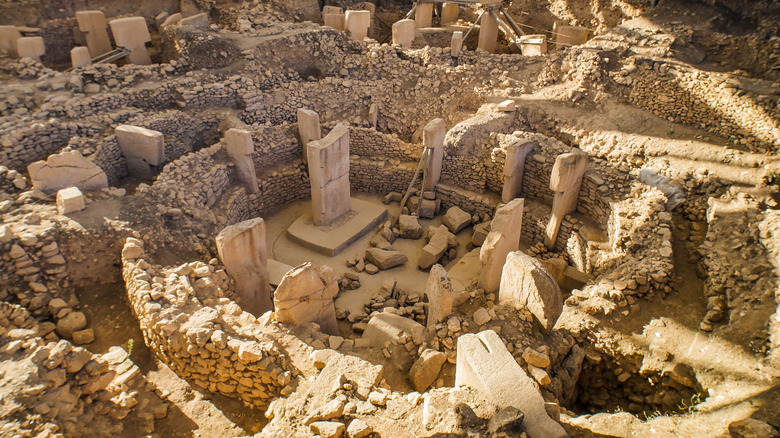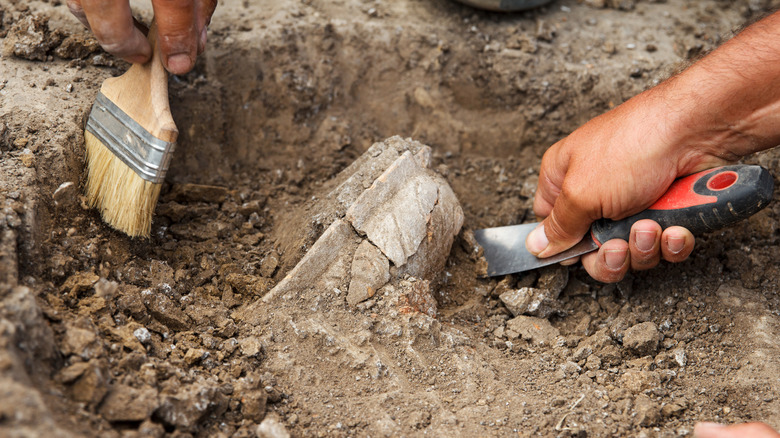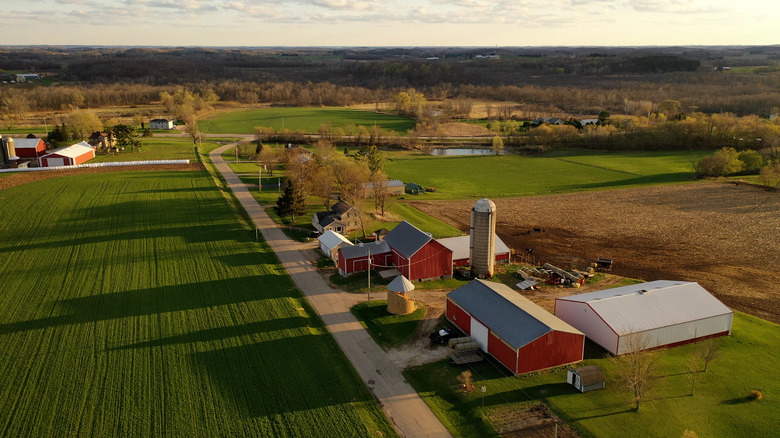The Untold Truth Of Karahan Tepe
Archaeological excavation is a trade like no other. New discoveries of ancient ruins sit before us like hidden keys to our ancestral past. Some discoveries support scientific theories that already exist. Others challenge them. The recent discovery of an 11,400-year-old village dubbed Karahan Tepe is particularly fascinating because it does the latter (via The Art Newspaper). Not only does this monumental site challenge modern science, but it also alters history in unparalleled ways.
The excavation of Karahan Tepe stands in staunch opposition to current narratives about the way ancient human beings started civilizations. It implicates that the timing of "settlement" as we have come to know it in the form of fixed plots of land, the establishment of communal gathering spaces, and the application of labor happened much earlier than previously believed. Even more interesting is the fact that this structure suggests the motive for such settlement was also previously misrepresented. This lone discovery could rewrite a massive chunk of history.
Karahan Tepe is approximately 11,400 years old
Initial discovery of the vast archaeological site known as Karahan Tepe, alternatively referred to as Karahantepe by some news sources, dates back to 1997 (via Daily Sabah). Over the course of the next two plus decades, the site was meticulously studied and eventually hailed as the world's first official temple. Presenting as a possible "zero point in history," many believed this newly found site might even predate Gobekli Tepe, another Turkey-based ancient structure that was once dubbed the world's oldest house of worship (via Smithsonian Magazine).
The latest research now confirms this theory (via The Art Newspaper). At approximately 11,400 years of age, Karahan Tepe does indeed predate Gobekli Tepe, but that's really just the beginning of its charm. As it turns out, this fascinating monumental site predates something even more exciting that changes the pages of history dramatically. This surprising new insight into ancient human history will change the way we view the dawn of agriculture and its mark on modern civilization.
Karahan Tepe predates the dawn of agriculture
It has long been believed and reported that human settlement and civilization as we now know it developed as a result of early agriculture (via Khan Academy). The prospect of the Neolithic Revolution and its ties to early civilizations are so rooted in the current academic model that settlement is often referred to in the context of agriculture, such as an "agricultural settlement." Smithsonian Magazine has even coined agricultural components as "the seeds of civilization." Back when Gobleki Tepe was still regarded as the oldest house of worship on the planet, this was a viable worldview. But as shovels dig, perspectives shift and ancient secrets are again revealed.
According to The Art Newspaper, excavators at Karahan Tepe uncovered some of the oldest villages in the world. Complete with homes that served as permanent settlements and complex tools and structures, these ancient villages set the stage for what we now know as civilization. However, something was also missing. This ancient village was completely void of evidence of agriculture, such as farmed vegetation. Associate professor of prehistory at Istanbul University Necmi Karul remarked, "our findings change the perception, still seen in schoolbooks across the world, that settled life resulted from farming and animal husbandry."
Clearly, this was simply not the case. So, if agriculture didn't inspire humanity to settle down, what did? The answer, based on archaeological evidence, is religion.
Karahan Tepe ruins feature remnants of spaces designated for worship
The more we unearth the fossils of our fabled past, fewer things are exactly the way they seemed. The Art Newspaper reports that an effort to build a society arose as the result of faith, not husbandry. It was faith that so inspired hunter-gatherers to construct these early dwelling spaces. It was faith that fueled the masses to create complex infrastructures, to construct communal gathering spaces, and to spin the wheels of revolutionary tech and fan the flames of innovation.
Much to the shock of scientists and historians, when shovels dug a little deeper into history this rich, what was found in place of farmland was something much more spiritual in nature. It is now believed that temples of worship and secular dwelling spaces predate the dawn of architecture by some 1,500 years. And this is not the first time a temple of worship has rewritten imagery of the past. When Gobekli Tepe was first discovered, it also challenged much of what we thought we knew about ancient societal norms (via Smithsonian Magazine).
Agriculture was the result of settlement
Until now, it was believed that all society and civilization hinged on the base desire of sustenance (via National Geographic). It was food and drink that made the world go round, and these were the staples of the postmodern landscape we see today, the fruits of that labor so to speak. This new revelation sheds a completely different light on that subject.
As we see that humanity settled down for the purpose of worship, living free of husbandry for thousands of years on end, we learn that agriculture was the result of settlement, not the cause. While the existence of Karahan Tepe clearly indicates the need for correction to historical texts on this basis, Istanbul University's professor emeritus of archaeology Mehmet Özdoğan believes there might be some reluctance to accept these new developments. "It will take time for the scientific community to digest and accept this game-changing research," said Özdoğan (via The Art Newspaper).
Karahan Tepe reveals a complex religious devotion
Further scrutiny of Karahan Tepe has also revealed multiple structures, each masterfully crafted and likely mapped out in advance (via The Art Newspaper). The circular spaces designed and constructed for worship speak volumes about the architect's expert abilities. But with each room, there is another element unspoken but understood. It is the idea that these ancient inhabitants also adhered to a complex system of religious beliefs that required such sophisticated planning.
One room stands out in particular. It is a large spherical chamber now believed to be a rites of passage room. It is replete with religious symbolism that not only exhibits these ancient human's complex spirituality, but also their ability to clearly distinguish human beings from the animals around them. Beyond the phallic and serpentine structures that stood symbolically in the background of these ancient humans' lives, there existed a deep respect for the temple itself, which appears to have been intentionally buried with the kind of care usually reserved for human remains.





